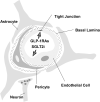The Relationship Between the Blood-Brain-Barrier and the Central Effects of Glucagon-Like Peptide-1 Receptor Agonists and Sodium-Glucose Cotransporter-2 Inhibitors
- PMID: 36035518
- PMCID: PMC9417299
- DOI: 10.2147/DMSO.S375559
The Relationship Between the Blood-Brain-Barrier and the Central Effects of Glucagon-Like Peptide-1 Receptor Agonists and Sodium-Glucose Cotransporter-2 Inhibitors
Abstract
Diabetes and obesity are growing problems worldwide and are associated with a range of acute and chronic complications, including acute myocardial infarction (AMI) and stroke. Novel anti-diabetic medications designed to treat T2DM, such as glucagon-like peptide-1 receptor agonists (GLP-1RAs) and sodium-glucose cotransporter-2 inhibitors (SGLT-2is), exert beneficial effects on metabolism and the cardiovascular system. However, the underlying mechanisms are poorly understood. GLP-1RAs induce anorexic effects by inhibiting the central regulation of food intake to reduce body weight. Central/peripheral administration of GLP-1RAs inhibits food intake, accompanied by an increase in c-Fos expression in neurons within the paraventricular nucleus (PVN), amygdala, the nucleus of the solitary tract (NTS), area postrema (AP), lateral parabrachial nucleus (LPB) and arcuate nucleus (ARC), induced by the activation of GLP-1 receptors in the central nervous system (CNS). Therefore, GLP-1RAs need to pass through the blood-brain barrier to exert their pharmacological effects. In addition, studies revealed that SGLT-2is could reduce the risk of chronic heart failure in people with type 2 diabetes. SGLT-2 is extensively expressed throughout the CNS, and c-Fos expression was also observed within 2 hours of administration of SGLT-2is in mice. Recent clinical studies reported that SGLT-2is improved hypertension and atrial fibrillation by modulating the "overstimulated" renin-angiotensin-aldosterone system (RAAS) and suppressing the sympathetic nervous system (SNS) by directly/indirectly acting on the rostral ventrolateral medulla. Despite extensive research into the central mechanism of GLP-1RAs and SGLT-2is, the penetration of the blood-brain barrier (BBB) remains controversial. This review discusses the interaction between GLP-1RAs and SGLT-2is and the BBB to induce pharmacological effects via the CNS.
Keywords: anorexic medications; central nervous system; chronic heart failure; sympathetic nervous system.
© 2022 Dong et al.
Conflict of interest statement
The authors report no conflicts of interest in this work.
Figures






Similar articles
-
An Overview of Similarities and Differences in Metabolic Actions and Effects of Central Nervous System Between Glucagon-Like Peptide-1 Receptor Agonists (GLP-1RAs) and Sodium Glucose Co-Transporter-2 Inhibitors (SGLT-2is).Diabetes Metab Syndr Obes. 2021 Jun 29;14:2955-2972. doi: 10.2147/DMSO.S312527. eCollection 2021. Diabetes Metab Syndr Obes. 2021. PMID: 34234493 Free PMC article. Review.
-
Protective Effects of Home T2DM Treatment with Glucagon-Like Peptide-1 Receptor Agonists and Sodium-Glucose Co-transporter-2 Inhibitors Against Intensive Care Unit Admission and Mortality in the Acute Phase of the COVID-19 Pandemic: A Retrospective Observational Study in Italy.Diabetes Ther. 2023 Dec;14(12):2127-2142. doi: 10.1007/s13300-023-01472-8. Epub 2023 Oct 6. Diabetes Ther. 2023. PMID: 37801224 Free PMC article.
-
Comparing the Efficacy and Safety of Glucagon-Like Peptide 1 Receptor Agonists with Sodium-Glucose Cotransporter 2 Inhibitors for Obese Type 2 Diabetes Patients Uncontrolled on Metformin: A Systematic Review and Meta-Analysis of Randomized Clinical Trials.Int J Endocrinol. 2020 Sep 28;2020:1626484. doi: 10.1155/2020/1626484. eCollection 2020. Int J Endocrinol. 2020. PMID: 33061964 Free PMC article. Review.
-
Spotlight on Canagliflozin 300: review of its efficacy and an indirect comparison to other SGLT-2 inhibitors and long-acting GLP-1 receptor agonists.Expert Rev Clin Pharmacol. 2017 Jun;10(6):633-647. doi: 10.1080/17512433.2017.1318061. Epub 2017 Apr 17. Expert Rev Clin Pharmacol. 2017. PMID: 28393583 Review.
-
Use of Diabetes Medications before and after a Heart Failure-Related Hospitalization among Nursing Home Residents.J Am Med Dir Assoc. 2024 Mar;25(3):454-458. doi: 10.1016/j.jamda.2023.06.033. Epub 2023 Aug 5. J Am Med Dir Assoc. 2024. PMID: 37553080 Free PMC article.
Cited by
-
Potential for reducing resting sympathetic nerve activity with new classes of glucose-lowering drugs in heart failure with preserved ejection fraction.Clin Auton Res. 2024 Feb;34(1):223-226. doi: 10.1007/s10286-023-01013-0. Epub 2024 Jan 29. Clin Auton Res. 2024. PMID: 38285071 Free PMC article. No abstract available.
-
Glucagon-like peptide-1 and impaired counterregulatory responses to hypoglycemia in type 1 diabetes.World J Diabetes. 2025 Feb 15;16(2):99928. doi: 10.4239/wjd.v16.i2.99928. World J Diabetes. 2025. PMID: 39959274 Free PMC article.
-
Glucagon-like peptide-1 receptor agonists, but not dipeptidyl peptidase-4 inhibitors, reduce alcohol intake.J Clin Invest. 2025 Mar 6;135(9):e188314. doi: 10.1172/JCI188314. eCollection 2025 May 1. J Clin Invest. 2025. PMID: 40048376 Free PMC article.
-
Recent Advances in Understanding the Molecular Mechanisms of SGLT2 Inhibitors in Atrial Remodeling.Curr Issues Mol Biol. 2024 Aug 31;46(9):9607-9623. doi: 10.3390/cimb46090571. Curr Issues Mol Biol. 2024. PMID: 39329923 Free PMC article. Review.
-
Comparative cardiovascular effectiveness of glucagon-like peptide-1 receptor agonists and sodium-glucose cotransporter-2 inhibitors in atherosclerotic cardiovascular disease phenotypes: a systematic review and meta-analysis.Eur Heart J Cardiovasc Pharmacother. 2025 Mar 13;11(2):174-189. doi: 10.1093/ehjcvp/pvae093. Eur Heart J Cardiovasc Pharmacother. 2025. PMID: 39923808 Free PMC article.
References
Publication types
LinkOut - more resources
Full Text Sources

